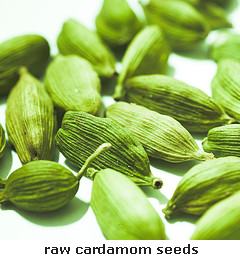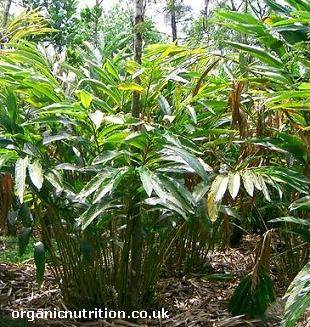Cardamom has numerous health benefits
Here are some of its traditional uses:
It is used extensively in cooking especially in India. Cardamom is a versatile and pleasant cooking spice. Used in beverages, main courses, and desserts, with sweets, savoury dishes, and fruits. Cardamom is also added to coffee in Saudi Arabia. Around the world, green cardamom is used in spiced cakes and breads.
 In traditional Indian medicine cardamom has many uses. Ranging from being considered an aphrodisiac to the treatment of digestive, cardiovascular and neurological conditions. In traditional medicine this spice is used for sexual dysfunctions like impotency and premature ejaculation.
In traditional Indian medicine cardamom has many uses. Ranging from being considered an aphrodisiac to the treatment of digestive, cardiovascular and neurological conditions. In traditional medicine this spice is used for sexual dysfunctions like impotency and premature ejaculation.
A nightly dose of a pinch of powdered cardamom seeds boiled in milk, and sweetened with honey has been done for a long time. However this has not been proven 100% by any formal medical studies, and falls under folklore. Having said that there has been practical though not scientific evidence of success.
It has been used successfully for bad breath
Cardamom is very aromatic. When chewed the seed leaves a warm and characteristically strong flavour in the month. Ancient Egyptians chewed cardamom to whiten their teeth and sweeten their breath. In modern times it is used in the treatment of halitosis – bad breath
Its use in maintaining healthy Blood Pressure
Researchers have studied cardamom, as a spice and health herb, for its potential ability to improve blood pressure levels and have recorded some positive results. It has shown to improve blood circulation to the lungs and can be helpful in prevention of spasms or convulsions. Cardamom soothes mucus membranes, hence, cardamom could be beneficial for those suffering from asthma or bronchitis.
As a Digestive Aid
One of Cardamom's main uses is as a digestive aid due to its soothing and antispasmodic properties (antispasmodic - something that suppresses muscle spasms). A study done on animals, which was published on the July-August Pharmacological Research edition in 1996, verified the antispasmodic properties of cardamom. It may help counteract excessive stomach acid as well as relieve flatulence and indigestion, while also enhancing appetite. Other studies have shown that cardamom can stimulate the production of bile and reduce gastric juices.
Powerful Anti-Bacterial and Anti-Viral benefits
Cardamom has shown to be able to inhibit the development and growth of viruses, fungi and bacteria. It could help in the treatment and reliving of conditions caused the above or by those individuals who have weakened resistance to infections and diseases.
Anti-inflammatory uses
Cardamom has also shown anti-inflammatory properties. It has been used in the treatment of sore throats, pharynx and mouth inflammations. Gargling with this infusion daily can also be useful in averting colds. Cardamom can produce expectorant effects and can lead to a reduction in the production of mucus.
Expectorant means: A promoting or facilitating the secretion or expulsion of phlegm, mucus, or other matter from the respiratory tract. (from the Latin expectorare, to expel from the chest)
It can be used as a Relaxant
The oil from cardamom seeds is often used in massage. These oils have been shown to help relax muscles. It can also help with the treatment of inflamed nerves, back muscles and joints that are swollen. This is probably connected to the antispasmodic properties of the herb when taken internally.
Some more background about the cardamom plant

Growing to around 2.4 metres, the Cardamom plant has smooth green cane-like stems and large dark green leaf blades sheathed at the base. The flower is yellowish with a purple lip, succeeded by the fruit and seeds. It is one of the most valued spices in the world.

